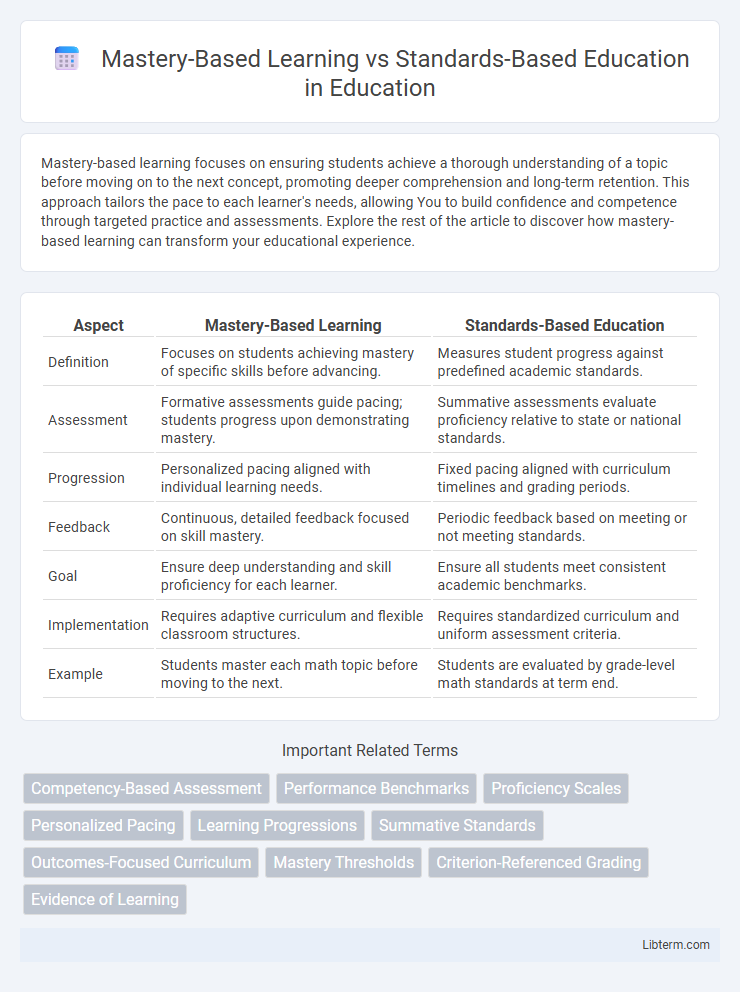Mastery-based learning focuses on ensuring students achieve a thorough understanding of a topic before moving on to the next concept, promoting deeper comprehension and long-term retention. This approach tailors the pace to each learner's needs, allowing You to build confidence and competence through targeted practice and assessments. Explore the rest of the article to discover how mastery-based learning can transform your educational experience.
Table of Comparison
| Aspect | Mastery-Based Learning | Standards-Based Education |
|---|---|---|
| Definition | Focuses on students achieving mastery of specific skills before advancing. | Measures student progress against predefined academic standards. |
| Assessment | Formative assessments guide pacing; students progress upon demonstrating mastery. | Summative assessments evaluate proficiency relative to state or national standards. |
| Progression | Personalized pacing aligned with individual learning needs. | Fixed pacing aligned with curriculum timelines and grading periods. |
| Feedback | Continuous, detailed feedback focused on skill mastery. | Periodic feedback based on meeting or not meeting standards. |
| Goal | Ensure deep understanding and skill proficiency for each learner. | Ensure all students meet consistent academic benchmarks. |
| Implementation | Requires adaptive curriculum and flexible classroom structures. | Requires standardized curriculum and uniform assessment criteria. |
| Example | Students master each math topic before moving to the next. | Students are evaluated by grade-level math standards at term end. |
Understanding Mastery-Based Learning
Mastery-Based Learning emphasizes student proficiency by allowing learners to progress upon demonstrating a deep understanding of specific skills or concepts, rather than moving forward based on time spent in class. This approach prioritizes personalized pacing, ensuring each student attains mastery before advancing to more complex material. Key metrics include mastery checkpoints, formative assessments, and continuous feedback to support individualized learning pathways.
Defining Standards-Based Education
Standards-Based Education centers on clearly defined learning goals aligned with academic standards set by educational authorities, emphasizing students' mastery of specific skills and knowledge at each grade level. It requires continuous assessment against these standards, enabling personalized feedback and targeted interventions to ensure all learners meet established proficiency criteria. This approach promotes consistency, transparency, and accountability in student learning outcomes across schools and districts.
Key Principles of Mastery-Based Learning
Mastery-Based Learning emphasizes personalized pacing, allowing students to progress only after demonstrating a thorough understanding of specific competencies. It prioritizes formative assessments and targeted feedback to ensure deep comprehension and skill acquisition before advancing. This learner-centered approach contrasts with Standards-Based Education by focusing on mastery of content rather than time-based progression or grade-level benchmarks.
Core Concepts of Standards-Based Education
Standards-Based Education centers on clearly defined learning objectives aligned with state or national standards, ensuring students acquire essential skills and knowledge at each grade level. This approach emphasizes measurable outcomes and continuous assessment to track mastery of core academic concepts, promoting consistency and equity in education. By focusing on specific standards, educators can tailor instruction to address gaps and support student growth with targeted interventions.
Assessment Methods: Mastery vs Standards
Mastery-Based Learning employs assessments designed to evaluate individual student proficiency on specific skills or concepts until mastery is demonstrated, often allowing multiple attempts and personalized pacing. In contrast, Standards-Based Education uses assessments aligned with predefined academic standards, measuring whether students meet or exceed grade-level expectations at set checkpoints. The key difference lies in Mastery-Based assessments focusing on deep understanding and skill acquisition, while Standards-Based assessments emphasize consistent performance against fixed benchmarks.
Student Progression and Pacing Differences
Mastery-Based Learning allows students to progress at their own pace by demonstrating complete understanding of a topic before moving forward, emphasizing personalized learning trajectories. In contrast, Standards-Based Education often follows a set timeline where students are assessed against uniform grade-level standards, which may result in varied mastery among peers. This pacing difference leads to more flexible progression in mastery-based systems versus a more structured, time-bound advancement in standards-based models.
Impact on Student Motivation and Engagement
Mastery-Based Learning enhances student motivation and engagement by allowing learners to progress at their own pace, ensuring they fully grasp concepts before moving forward, which builds confidence and intrinsic motivation. Standards-Based Education provides clear performance benchmarks, promoting student awareness of expectations and goals, but may sometimes lead to pressure and competition. Both approaches influence motivation differently, with Mastery-Based Learning fostering deeper engagement through personalized mastery, while Standards-Based Education emphasizes meeting predefined criteria.
Teacher Roles and Responsibilities
Teacher roles in mastery-based learning center on facilitating individualized pacing and providing targeted feedback to ensure students achieve specific competencies before advancing. In standards-based education, educators focus on aligning instruction with predefined academic standards, regularly assessing student progress to meet or exceed those benchmarks. Both approaches require teachers to adapt strategies to support diverse learning needs while maintaining clear communication with students and parents about learning objectives and outcomes.
Challenges and Criticisms of Both Approaches
Mastery-based learning faces challenges such as the extensive time required for individualized pacing, which can strain resources and complicate scheduling in traditional classrooms. Standards-based education often encounters criticism for promoting a checklist mentality that may overlook deeper understanding and fail to accommodate diverse learning styles. Both approaches struggle with assessment validity, as mastery learning demands consistent, formative evaluations, while standards-based systems risk emphasizing test performance over comprehensive skill development.
Choosing the Right Approach for Your School
Mastery-Based Learning emphasizes student progress through demonstrating proficiency in specific skills before advancing, fostering personalized pacing and deeper understanding. Standards-Based Education aligns instruction and assessment strictly with predetermined grade-level benchmarks, ensuring uniform achievement across a student population. Selecting the right approach depends on your school's goals, resources, and student needs, balancing personalized mastery with consistent standards compliance.
Mastery-Based Learning Infographic

 libterm.com
libterm.com